Subtotal: $
Checkout-

Excerpt: Mandela and the General
-

Why We Live in Community: A Manifesto
-

Editor’s Picks Issue 18
-

The Sacred Bonds of Sound
-

Making Music for Community
-

A Man of Honor
-

Wassily Kandinsky
-

Giant Picnic
-

Covering the Cover: The Art of Community
-

The Art of Community
-

Readers Respond: Issue 18
-

Family and Friends: Issue 18
-

I Did Not Leave
-

Summer of the Tree House
-

Warriors on Stage
-

The Beauty of Belonging
-

Insights on Beauty
-

It Could Be Anyone
-

All About Light
-

Making a Work of Art
-

The Business of the Artist
-

The Creative Process

Return to Appalachia
Why two young women went to Ohio to teach children art in a barn
By Susannah Black Roberts
December 3, 2018
Next Article:
Explore Other Articles:
In November 2016 Hillary Wagner and Francesca Fiore were beginning their last year at Parsons School of Design in New York City. Although they had been following national politics, it was a local issue that captured Hillary on the day of the election: the school arts program in her rural Appalachian hometown was in danger of having its funding cut.
“I was horrified by this prospect,” she says, “recalling how already scant my opportunities had been as a creative child growing up in Bethel, Ohio. I cried a puddle on Francesca’s studio floor on the day of the election.”
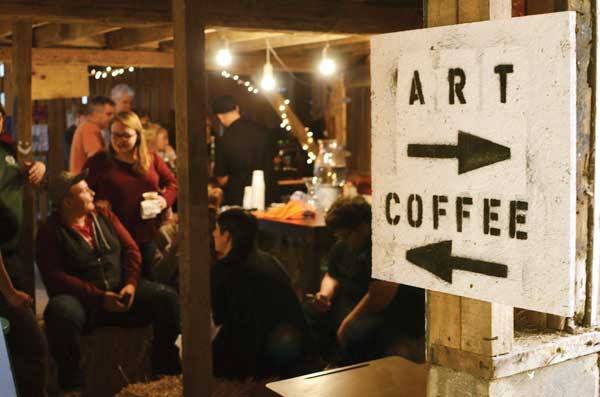
Friends and neighbors visit the Barn Studio during an exhibition, 2017.
But later, in a diner off Union Square in lower Manhattan, the two women began to get an idea, fueled by their knowledge of art, community building, and political activism: to start a community arts program that would serve the town’s children and help reconnect those kids to their local history and agricultural roots. Sadness and anger turned to excited planning as they decided that they, with Francesca’s husband, Matthew Kosinski, should move to Bethel immediately after graduation. In the spring of 2017, with two freshly-minted MFAs, they did.
Bethel, Ohio, faces formidable problems. Many area families live in poverty, struggling to afford groceries. Feeling little connection to their town and its history, young people are eager to leave. Francesca and Hillary were convinced that an arts program could push back against some of these problems to draw together a fragmented community. They called the project SOIL SERIES, aiming to help preserve the town’s links to its agricultural past.
Most locals don’t make a living from agriculture anymore, but a few generations ago the land was home to many subsistence farmers. This history, Hillary says, reached forward into her own life. “When I was a little girl my great grandparents were still operating their small dairy farm, and I loved helping them with the milking and the garden. My earliest memory (I was probably two or three) is of my grandfather setting me up high on the back of a Holstein bull.”
But, as was the case with so many families in the area, with the death of her great grandfather in 2003, her family’s farming tradition died as well: “I have spent much of my life consciously or unconsciously trying to reconnect with that tradition of love and a deep, intimate knowledge of the land and its creatures… I have only recently begun to truly understand and thus value my Appalachian identity.”
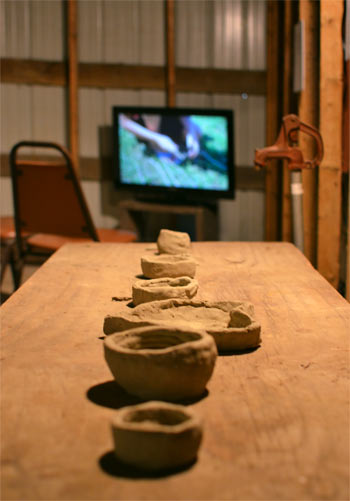
Pinch pots made by young artists with clay sourced from a creek at the Ranch, 2017
When Hillary was growing up in Bethel she saw a great deal of community strength, some of which is still present. But despite this, times got harder; she “saw businesses in the town struggle and fail so often it felt normal.” She heard her parents, public school teachers, talk about the increasing percentage of students on free and reduced lunch, and the ever-looming threat of cuts and failed emergency operating levies. Returning to Bethel meant facing high poverty and unemployment rates, but it also meant seeing the burgeoning local efforts to meet those needs.
Scott and Lori Conley’s Bethel-based organization, Empower Youth, attempts to help kids break out of generational poverty. Each Friday they provide bags of food so over six hundred students will have enough for the weekend. The Conley’s program also helps students plan and pursue their own goals, supporting them through high school graduation, encouraging them to apply to college, and helping them get work experience. During the summer of 2017 Francesca, Matthew, and Hillary enlisted a group of Empower Youth’s teenage interns. Together they rehabbed an old barn on the Empower Youth Ranch into a studio space.
The goal was to create space for the art lessons that Francesca and Hillary were busy preparing. Working on the space itself, however, became a crucial part of their relationship with the community, Hillary says: “As we guided the students through the renovation of the Barn Studio, they opened up to us, sharing about their lives while painting walls and patching concrete floors. Many came from troubled, complex homes. Many had difficulty imagining hopeful futures. As their struggles became known to us, we worked intentionally to introduce new ideas about politics and culture, art and life. We tried our best to be courageous in our own personal circumstances in order to be examples to them for how to be gracious in strife and strong to overcome obstacles.”
Once the Barn Studio was finished the lessons began. Children in the group range from ages five to thirteen. The program has been so successful that they can’t accept more children into it.
Now in their second summer with SOIL SERIES, Hillary, Francesca, and Matthew must juggle designing and running this project with the very real challenge of affording it. Hillary and Francesca write grant applications and pursue other potential sources of funding while Matthew works remotely. During the year Hillary substituted in the local school. This summer she’s been working at Home Depot to help them stay afloat, and she’s lined up several adjunct classes to teach at Northern Kentucky University starting in the new school year. People from the community have contributed donations and art supplies.
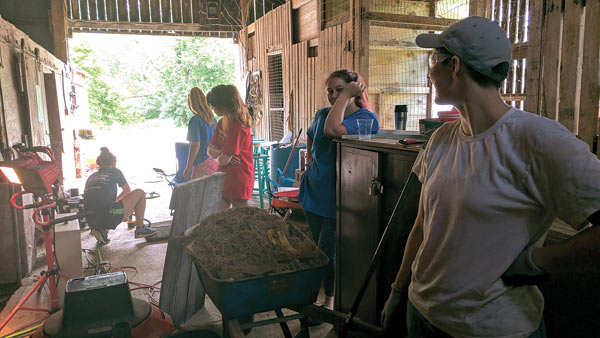
Empower Youth interns and volunteers renovate the Barn Studio, 2017.
The Conleys see the value that Hillary, Matt, and Francesca are bringing. In their words, “This is the opportunity for the students of Appalachia to experience art beyond a Vacation Bible School salt dough project or more formal art taught in their schools. Hillary, Francesca, and Matt made art personal … and relatable. Their work with the students was secondary only to the impact they made on the older interns who built relationships with them.”
This second summer Hillary and Francesca have focused on artists within the Bethel community. One woman spins her alpacas’ fleece into yarn, crochets, and weaves – thus, a series on textiles that allows students to try weaving. A member of a local family’s bluegrass band has performed at the Grand Ole Opry; students have learned about the distinctive musical heritage of Appalachia and have made their own instruments. The goal, Hillary says, is for students to “recognize their home as a place where people are already being creative.”
Through these community members Hillary and Francesca’s vision of weaving agriculture into the program is also coming to pass. They’ve discovered that although agriculture no longer sustains local families, many still have small-scale farms. “We went to Daniel because he was a musician,” Hillary says, “but he also has a farm. We went to Erica because she does textiles, but she also has a farm. Seems like everybody, alongside what they’re doing, has a farm.”
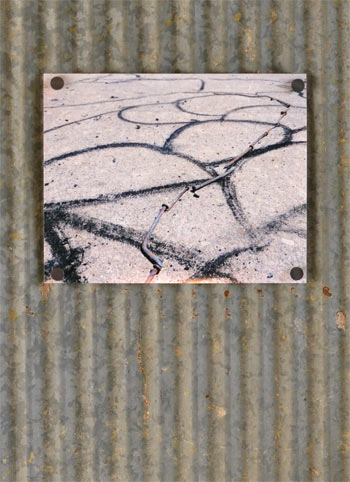
Drawing made on a concrete slab with materials found around the Ranch, 2017
SOIL SERIES is reminiscent in ways of the Foxfire project of the 1960s, in which a teacher helped his Appalachian students record (and learn) the skills, lore, and practices of their elders. But the issues that today’s Appalachian youth face are decidedly contemporary. Students have shared stories of “being out in public and seeing somebody overdose, like at the gas station,” says Francesca; “It’s just the atmosphere we live in.” Against challenges like this, can art classes for kids really make a difference? Francesca and Hillary are convinced they can. One student’s mother reported that before he started coming to the studio, he would vomit in school every day from anxiety. Since he’s begun art classes he no longer does. And they are making a difference for the young adults as well. Francesca and Hillary told the young people about the intersection of politics and the arts in earlier decades: ACT UP’s response to the AIDS crisis, The Guerilla Girls’ artistic challenge to sexism and racism. Inspired, the students formed an art collective. They’re high schoolers and recent graduates. One nineteen-year-old is working a construction job. He’d been helping out at Empower Youth, hauling boxes. When work began on the barn renovation he pitched in, and when the studio was done, he stayed around to make art. Since then he’s beginning to relate his art in the studio with the industrial pipe work at his job. Maybe one day he’ll have a sculpture practice.
I think it works because we love each other. We’re like family.
The art collective has been working on projects closely tied to Bethel’s history. They’ve done research on the town as a stop on the Underground Railroad. They’ve combed the historical society for photographs and articles to incorporate into collages. They even created an image for a billboard on the main road through town. They spend hours and days together, always making something. According to Hillary, the art collective is the program’s greatest success. “These kids have just transformed, given the opportunity to think differently about themselves, about Bethel, and about art. And I think it’s because we love each other. We’re like family. And the space is their own: it’s not within school, it’s not within church, it’s something else, and the kids are designing it for themselves.”
Though it’s not within church, for Hillary, this work is a kind of worship. Her Christian faith drives what she hopes to do in Bethel and serves as a bridge to others in the community. She and Francesca see that reknit community as the real work of art they are trying to make. They call it a “social drawing,” a version of the “social sculpture” of 1970s expressionist artist Joseph Beuys. Beuys thought of all society as a work of art. Francesca and Hillary are convinced the same is true of this Appalachian town. The art that the community is making, Matthew writes, exists as linkages between people: “God, according to Hillary’s belief, is also there in the linkages – the very linkages that give SOIL SERIES its transformative capacity. In this way, Hillary’s faith helps guide both the social drawing’s form and the ends to which it aspires.”
Hillary grew up in the church; four generations of her family have been in the Nazarenes, a denomination devoted to missions. “I was always a part of service projects; it’s second nature.” For a long time, that seemed to be in tension with her love of art-making. “I couldn’t get away from making things,” she said. “I thought that to be an artist I had to live this solitary existence, but I loved being with people.”
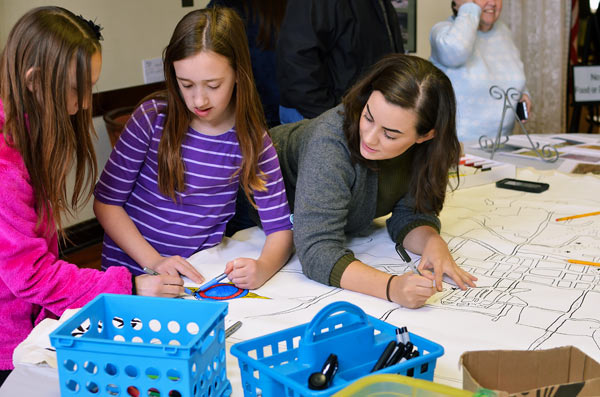
Hillary Wagner working with young artists, 2017
One way do this, she finds, is to spend her Sunday afternoons making art with teenagers. “It’s hard to describe exactly the way this house feels when all the kids are here … It’s weird just how much joy there is – the way this has transformed the kids, and the changes we see in them – we’re in awe. We had these theories about what could happen, but the actual experience of it – it’s that glimpse of heaven, that momentary thing.”
Given the opportunity to think differently about themselves and about art, these kids have just transformed.
All of the collaborators on the project, Christian or not, are sowing hope, attempting to plant good seeds in Bethel. Matthew and Francesca are atheists, and their East Coast Catholic upbringings were culturally distant from the low-church Protestantism that is common in Bethel, yet Matthew sees the impact of faith in the work they do. “People who believe in God seem to have easier access to the sublime in their everyday lives, which would be fair to say about many of the people I’ve met in Bethel. They feel God coursing through unlikely places… That feeling of God turns to an energizing awe, and that energizing awe transforms a dilapidated foreclosed ranch into a communal hub of social, intellectual, artistic, spiritual, and literal nourishment.”
Hillary and Francesca’s vision to help Bethel’s young people seems gradually to be coming true. “Our hope,” they say, “is that these students will know that they are capable of achievement because they are from Appalachia, not in spite of it.”
Photographs courtesy of Hillary Wagner. Used by permission.
Already a subscriber? Sign in
Try 3 months of unlimited access. Start your FREE TRIAL today. Cancel anytime.
































